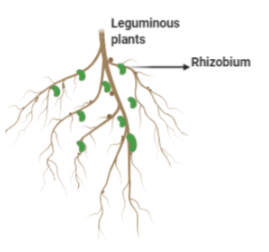
Answer
452.7k+ views
Hint: The organism which is associated with leguminous plants is a bacterium that is gram-negative bacteria.
Step by step answer:In option A, Rhizobium is mentioned. Rhizobium is a genus of bacteria. These bacteria live in symbiosis with legumes. They are present in the soil. They attach themselves to the roots of the leguminous plant and form nodules.
In option B, Nostoc is mentioned. It belongs to a genus of cyanobacteria/blue-green algae. It contains two pigments that are blue phycocyanin and red phycoerythrin. Also, they contain chlorophyll. They have the ability to fix the nitrogen in specialized cells called heterocysts. It has been researched that Nostoc is used in secondary metabolite reproduction which is considered harmful for human beings.
In option C, Spirogyra is mentioned. It is also known as water silk. It is an alga. It has a spherical arrangement of chloroplasts which makes it renowned.
In option D, Clostridium is mentioned. It is a genus of bacteria. They are gram-positive. The members of this genus are human pathogens. They are the causative agents for diseases like tetanus and botulism.

So, the correct option is option A
Note: The symbiotic relationship between Rhizobium and the plants. A symbiotic relationship between two species or organisms is a type of interdependent relation. Both of the organisms involved rely on each other for something valuable. The Rhizobium forms nodules. These nodules fix atmospheric nitrogen for plants in those nodules and convert them into ammonia which can be used by the plant for its growth and development. They, in return, get nutrition for their survival.
Step by step answer:In option A, Rhizobium is mentioned. Rhizobium is a genus of bacteria. These bacteria live in symbiosis with legumes. They are present in the soil. They attach themselves to the roots of the leguminous plant and form nodules.
In option B, Nostoc is mentioned. It belongs to a genus of cyanobacteria/blue-green algae. It contains two pigments that are blue phycocyanin and red phycoerythrin. Also, they contain chlorophyll. They have the ability to fix the nitrogen in specialized cells called heterocysts. It has been researched that Nostoc is used in secondary metabolite reproduction which is considered harmful for human beings.
In option C, Spirogyra is mentioned. It is also known as water silk. It is an alga. It has a spherical arrangement of chloroplasts which makes it renowned.
In option D, Clostridium is mentioned. It is a genus of bacteria. They are gram-positive. The members of this genus are human pathogens. They are the causative agents for diseases like tetanus and botulism.

So, the correct option is option A
Note: The symbiotic relationship between Rhizobium and the plants. A symbiotic relationship between two species or organisms is a type of interdependent relation. Both of the organisms involved rely on each other for something valuable. The Rhizobium forms nodules. These nodules fix atmospheric nitrogen for plants in those nodules and convert them into ammonia which can be used by the plant for its growth and development. They, in return, get nutrition for their survival.
Recently Updated Pages
Who among the following was the religious guru of class 7 social science CBSE

what is the correct chronological order of the following class 10 social science CBSE

Which of the following was not the actual cause for class 10 social science CBSE

Which of the following statements is not correct A class 10 social science CBSE

Which of the following leaders was not present in the class 10 social science CBSE

Garampani Sanctuary is located at A Diphu Assam B Gangtok class 10 social science CBSE

Trending doubts
A rainbow has circular shape because A The earth is class 11 physics CBSE

Which are the Top 10 Largest Countries of the World?

Fill the blanks with the suitable prepositions 1 The class 9 english CBSE

How do you graph the function fx 4x class 9 maths CBSE

The Equation xxx + 2 is Satisfied when x is Equal to Class 10 Maths

What is BLO What is the full form of BLO class 8 social science CBSE

Give 10 examples for herbs , shrubs , climbers , creepers

What organs are located on the left side of your body class 11 biology CBSE

Change the following sentences into negative and interrogative class 10 english CBSE




